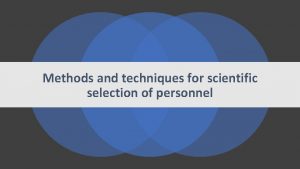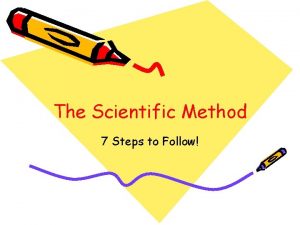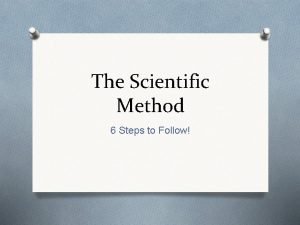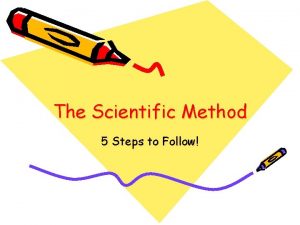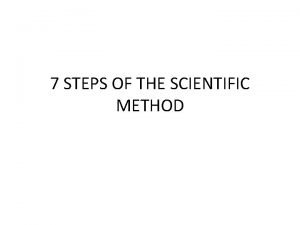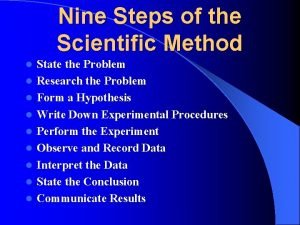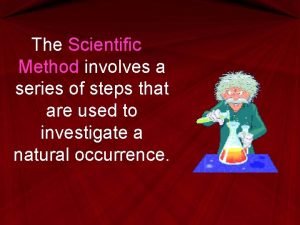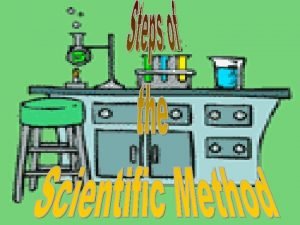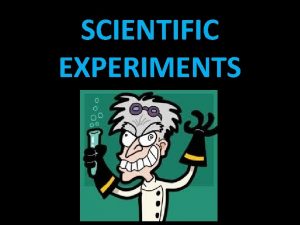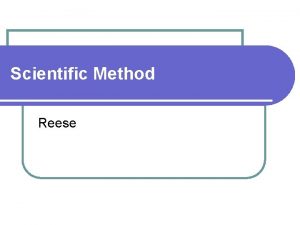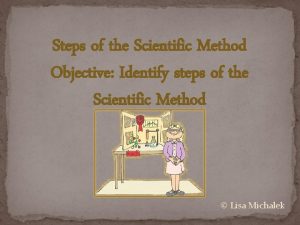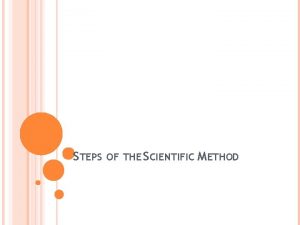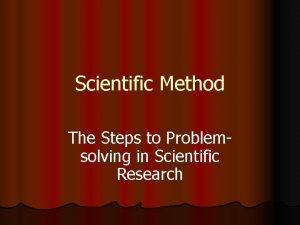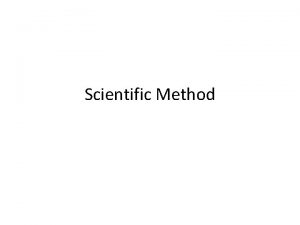Steps of the Scientific Process Introduction to the



















- Slides: 19

Steps of the Scientific Process

Introduction to the Scientific Process • A logical, problem solving technique • Not just scientific problems

Introduction to the Scientific Process Identify a problem Gather Information Formulate a hypothesis Analyze Data Record and Organize Data Design and Experiment Draw Conclusions Use conclusions to develop a new hypothesis

Step 1: Identify a Problem • Observe the world around you • Using observations, identify a problem you would like to solve • Example: Why do termites follow the ink line? http: //www. youtube. com/watch? v=h 7 HCX 1 OCd. Sk • This is a question you DO NOT know the answer to and can’t look up. • “Why” and “What would happen if. . ” are good beginnings of scientific questions.

Remember? Observation • Uses our 5 senses to gather information • Qualitative: • – The termites follow a circle made with a blue pen on white paper • Quantitative: uses numbers – 3 termites follow a circular blue pen line that is 5 cm in diameter We use observations when identifying a problem and asking a question? Will termites follow any color line on white paper? What will you measure!!!!!!!!!!!!!

Step 2: Gather Background Information- What is known? • Use references to do background research – – – – Books Journals Magazines Internet TV Videos Interview Experts • Example: Termites – Live underground – Do not see in color – See only black and shades of gray and white www. goldstarexterminators. net

Step 3: Formulate a Hypothesis Example: Termites • Possible answer to a question that can be tested • Based on observations and knowledge • “If” “Then” “Because” statement • Termites: – If the termites follow a circular path made with a dark blue colored pen on a white background then they will follow a circular path made with a dark red colored pen on a white background. Do we use observation or inference to formulate a hypothesis? Inference-A logical interpretation of events based on prior knowledge or opinion. Termites follow the blue line because the like it? ? ? Termites will follow any circular pattern on a light paper made with any dark colored pen because they see in black and white.

Step 4: Develop an Experiment Materials: Procedure: • A list of all the things you need • At least 5 termites • At least 3 replicates • Step by step instructions • Can be repeated by anyone • How to display what you measure • Identifies the variables used in the experiment How would you describe how to make a Peanut Butter and Jelly Sandwich to someone who had never done it? To someone who didn’t know what peanut butter or jelly is?

Variables in the Experiment: Independent Variable • The variable I (the scientist) change or manipulate • Example: – The color of pen used (red in the place of blue) Other Experiments: – The brand of pen used – The color of paper under the termites – The shape of the path

Variables in the Experiment: Dependent Variable • Is measured in the experiment • Changes because of the independent variable (pen color) • “Depends” on the independent variable • Examples: – How many termites follow the dark red line after following the dark blue line? (whole number) – How long do the termites follow the lines? (time) – Over what distance do they follow the line? (distance)

Variables: Constant • All the factors in the experiments that are kept the same • Everything except the independent variable • Keeps the experiment ‘fair’ Examples: • If you test color of paper, keep the color of pen constant • If you test the smell of pen, keep the color and type of pen constant (only change smell) • The exact termites used • The time of day and how long the termites are there • The shape of the line drawn

Variable: The Control • The normal condition that you compare the other conditions to • Recreate the conditions you first observed • Example: – Termites in a Petri dish on white filter paper follow a blue line (. 5 mm) with a bic pen in a circular shape of 5 cm in diameter.

Step 5: Record and Organize Data • Write all observations and measurements • Use a table to organize your data – List your independent variable on the left side – Record your dependent variables on the right side • If you have more than one dependent variable, use a new column for each dependent variable Independent Variable Dependent Variable: Over what distance did they follow the line? (cm) Blue ink on white paper Red ink on white paper Which one of these independent variables is the control? Which part of the independent variable is the constant?

Step 6: Analyze Data • “A picture is worth a thousand words” • Compare and look for trends and patterns using graphs

Number of Termites following entire circular path Bar Graph-Categorical Data Legend Red pen Blue pen for

Line Graph Number of Termites Number of termites on the ink line for 40 seconds Line graphs are used for time interval data

Pie Chart A Pie Chart adds up to a whole – 100% or all of something

Step 7: Make Conclusions • You must repeat the experiment to make the data valid • You should run your experiment at least 3 times to confirm your results How many times? – You can run all the experiments at one time, or run one after the other • Each separate experiment is called a Repetition (or Rep). • At least 5 organisms per replicate in order to do statistics and make conclusions

FYI • http: //www. youtube. com/watch? v=nl 1 ECK 6 Vnmo&f eature=related • http: //www. youtube. com/watch? v=Jzc. T_g 632 Q&feature=related • http: //www. youtube. com/watch? v=4 Clwpgt. WP_Y&f eature=related • http: //www. youtube. com/watch? v=x. RIGwg. AIu 8&feature=related
 Scientific selection procedure
Scientific selection procedure Information gathered during an experiment
Information gathered during an experiment How is a scientific law different from a scientific theory?
How is a scientific law different from a scientific theory? 7 steps of the scientific method
7 steps of the scientific method 7 steps of the scientific method
7 steps of the scientific method Scientific method seven steps
Scientific method seven steps What are the 6 steps of the scientific method
What are the 6 steps of the scientific method The five steps of the scientific method
The five steps of the scientific method Variables and controls
Variables and controls Scientific method steps
Scientific method steps What is the conclusion in the scientific method
What is the conclusion in the scientific method Scientific method steps
Scientific method steps Seven steps to the scientific method
Seven steps to the scientific method 7 steps of the scientific method
7 steps of the scientific method Steps of scientific method
Steps of scientific method Six steps to the scientific method
Six steps to the scientific method What are the nine steps of the scientific method
What are the nine steps of the scientific method Scientific method steps
Scientific method steps Scientific method steps
Scientific method steps Scientific method steps
Scientific method steps
